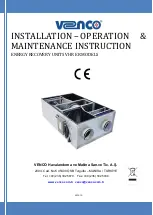
HT-X1
– i –
IMPORTANT SERVICE NOTES
BEFORE RETURNING THE AUDIO PRODUCT
BEFORE RETURNING THE AUDIO PRODUCT
(Fire & Shock Hazard)
Before returning the audio product to the user, perform the following
safety checks.
1. Inspect all lead dress to make certain that leads are not pinched or
that hardware is not lodged between the chassis and other metal
parts in the audio product.
2. Inspect all protective devices such as insulating materials, cabinet,
terminal board, adjustment and compartment covers or shields,
mechanical insulators etc.
3. To be sure that no shock hazard exists, check for leakage current in
the following manner.
* Plug the AC line cord directly into a 120 volt AC outlet.
* Using two clip leads, connect a 1.5 kohm, 10 watt resistor paralleled
by a 0.15 µF capacitor in series with all exposed metal cabinet parts
and a known earth ground, such as conduit or electrical ground con-
nected to earth ground.
* Use a VTVM or VOM with 1000 ohm per volt, or higher, sensitivity to
measure the AC voltage drop across the resistor (See diagram).
* Connect the resistor connection to all exposed metal parts having a
return path to the chassis (antenna, metal cabinet, screw heads,
knobs and control shafts, escutcheon, etc.) and measure the AC
voltage drop across the resistor.
All check must be repeated with the AC line cord plug connection
reversed.
Any reading of 0.3 volt RMS (this corresponds to 0.2 milliamp. AC.) or
more is excessive and indicates a potential shock hazard which must
be corrected before returning the audio product to the owner.
1. Employing lead-free solder
"
Amp./Power1/Power2/Display/Main/LED/Switch/Headphones/Tuner
" of this model employs lead-free solder. The LF symbol indicates
lead-free solder, and is attached on the PWB and service manuals. The alphabetical character following LF shows the type of
Example:
Indicates lead-free solder of tin, silver and copper.
2. Using lead-free wire solder
When fixing the PWB soldered with the lead-free solder, apply lead-free wire solder. Repairing with conventional lead wire sold
er
may cause damage or accident due to cracks.
As the melting point of lead-free solder (Sn-Ag-Cu) is higher than the lead wire solder by 40
C, we recommend you to use a
dedicated soldering bit, if you are not familiar with how to obtain lead-free wire solder or soldering bit, contact our service
station
or service branch in your area.
3. Soldering
As the melting point of lead-free solder (Sn-Ag-Cu) is about 220 C which is higher than the conventional lead solder by 40
C,
and as it has poor solder wettability, you may be apt to keep the soldering bit in contact with the PWB for extended period of
time. However, Since the land may be peeled off or the maximum heat-resistance temperature of parts may be exceeded,
remove the bit from the PWB as soon as you confirm the steady soldering condition.
Lead-free solder contains more tin, and the end of the soldering bit may be easily corrected. Make sure to turn on and off the
power of the bit as required.
If a different type of solder stays on the tip of the soldering bit, it is alloyed with lead-free solder. Clean the bit after e
very use
of it.
When the tip of the soldering bit is blackened during use, file it with steel wool or fine sandpaper.
Be careful when replacing parts with polarity indication on the PWB silk.
Lead-free wire solder for servicing
Ref No.
Description
Parts No.
PWB-A
DUNTKV550SJ03
Amp./Power1/Power2
PWB-B
DUNTKV549SJ03
Display/Main/LED/Switch/Headphones/Tuner
lead-free solder.
TO EXPOSED
METAL PARTS
CONNECT TO
KNOWN EARTH
GROUND
TEST PROBE
0.15 mF
1.5 kohms
10 W
VTVM
AC SCALE
Содержание HT-X1
Страница 11: ...HT X1 3 4 MEMO ...
Страница 23: ...HT X1 5 2 3 Waveforms of circuit ...
Страница 54: ...HT X1 7 5 MEMO ...
Страница 58: ...HT X1 8 4 MEMO ...
Страница 91: ...HT X1 1 MEMO ...



































